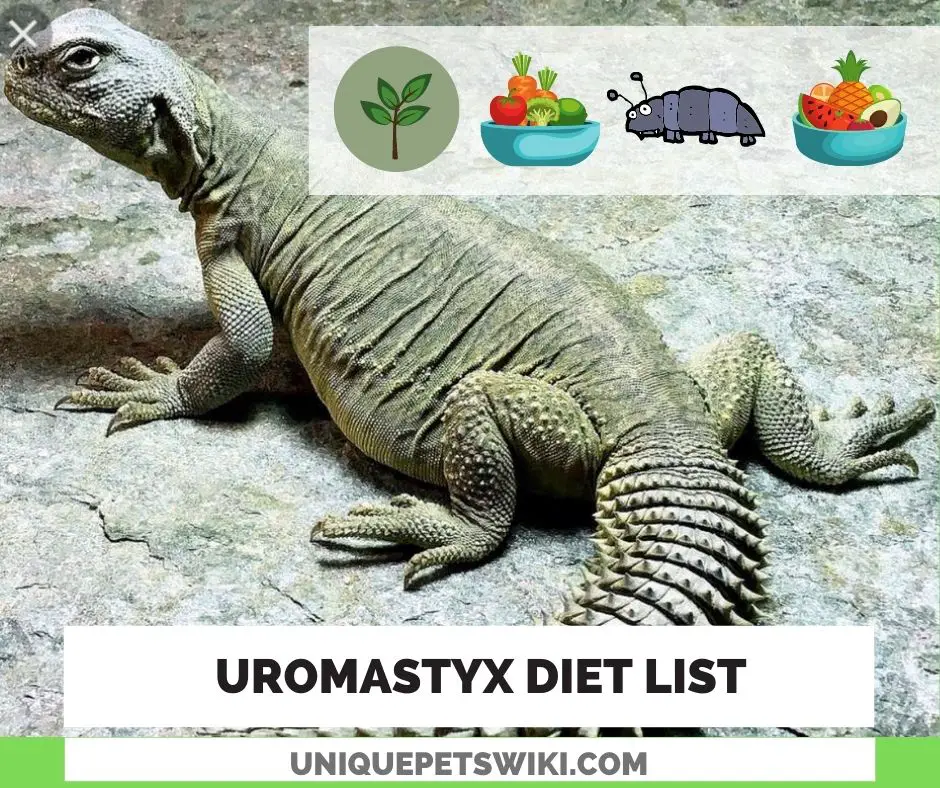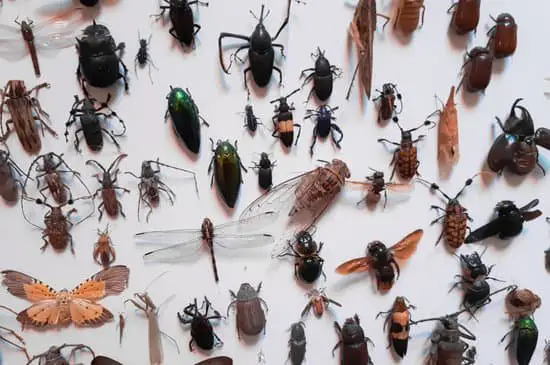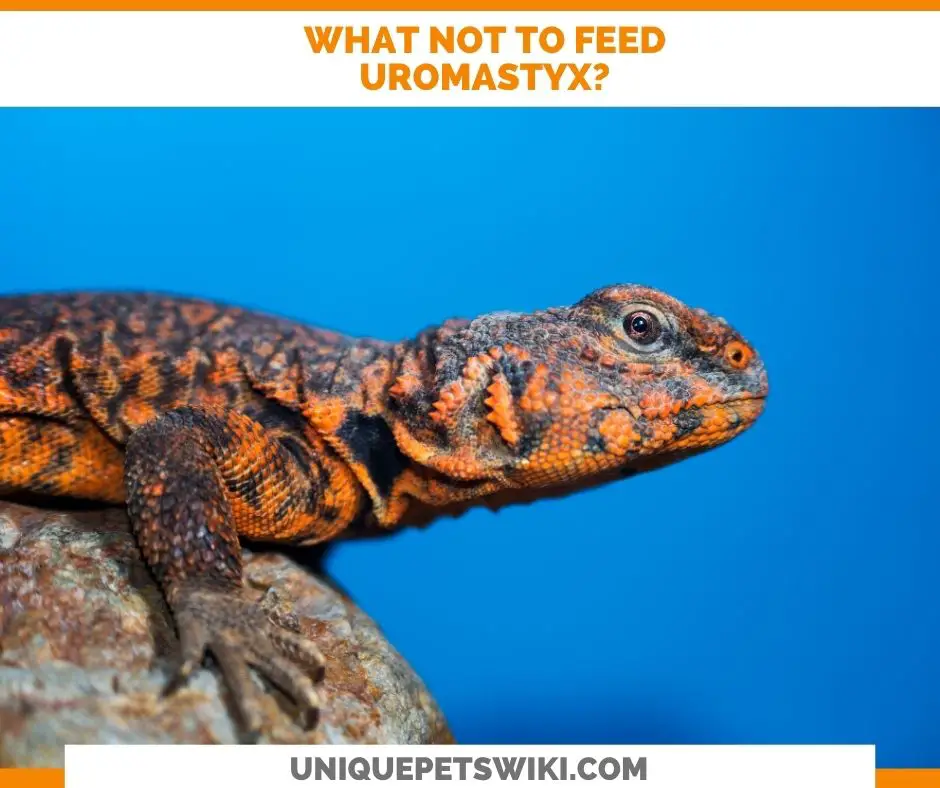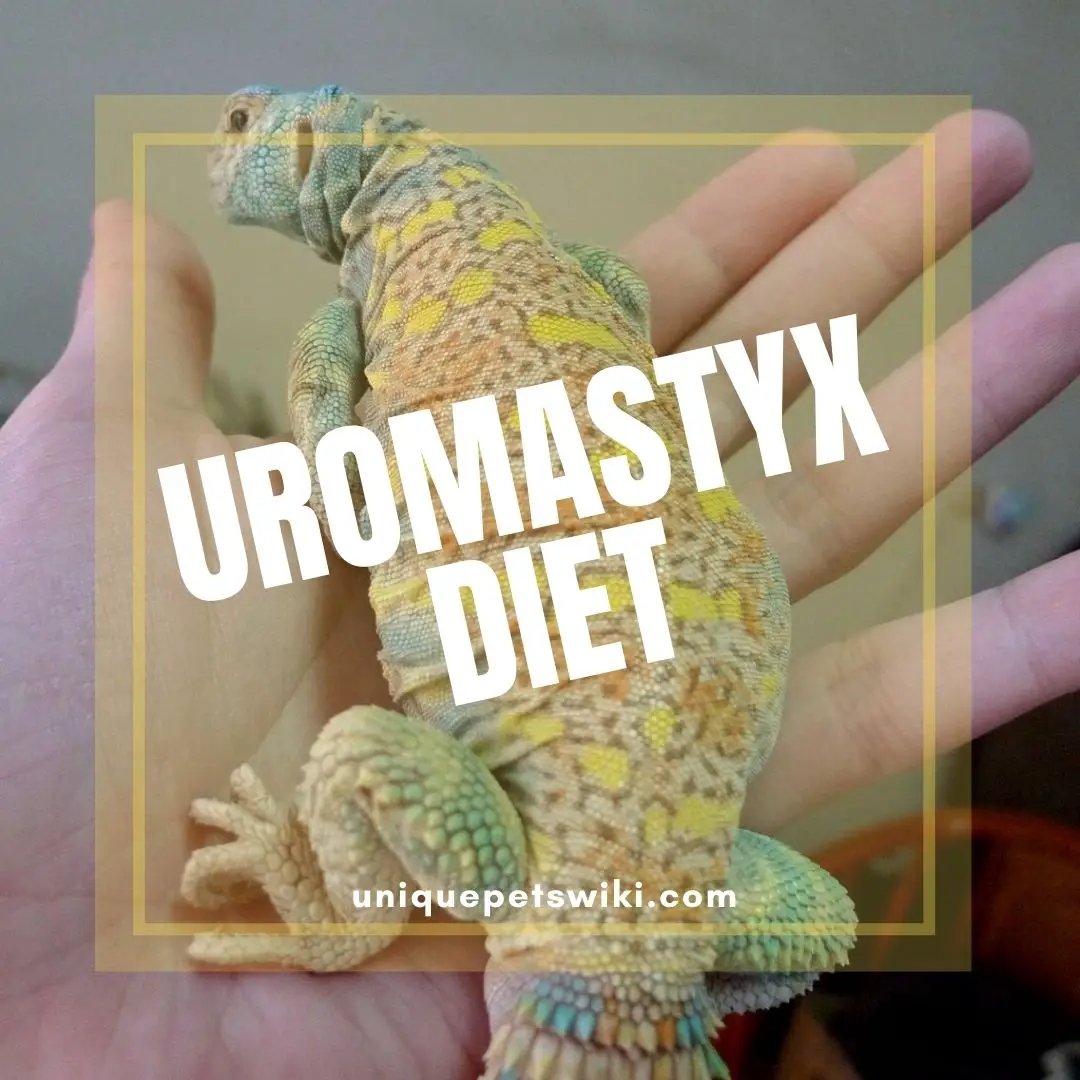Have you ever been in a discussion with breeders arguing about whether to feed insects to pet uromastyx or not? It’s one of the most controversial topics in uromastyx care.
After reading this article, you’ll know if it is healthy or harmful to feed certain foods to your pet uromastyx. We like going by thorough research and a session of interviews with many experienced and long-time breeders.
Thus, the information contained in this article is not mere speculation but facts that other breeders have established through their many years of experience and field trips.
That said, keep reading to dissolve your doubts.
This article has been reviewed by Dr. Gospel. Read more about our knowledge control process here.
Contents
Uromastyx Diet List: What Do Uromastyx Eat?

In the wild, uromastyx eat mainly greeny leaves according to their availability. These include dandelion leaves, Acacia flowers, mustard greens, and many others.
Depending on the native location, some species feed on flowers and fruits. From our research and interview with some breeders and field researchers, uromastyx weren’t seen to eat insects in the wild.
Going by the analysis of their fecal droppings, insects were seen to make up only one percent of their diet. And it could have turned out that some of those insects they eat in the wild were on the flowers and fruits that they consume as their main food.
However, some breeders said that they noticed their pet uromastyx having a high appetite for insects such as crickets. If they don’t eat much of insects in the wild but desire for some in captivity, it could only mean that they probably don’t like the taste of the insects in the wild.
To buttress further, aside from the fact that uromastyx don’t require too much animal protein in their diet, another reason for them not eating insects in the wild could be that the available insects that they would come across are not palatable.
Uromastyx are desert-dwelling lizards. With this in mind, the major kinds of insects likely to be found in the deserts are going to be beetles. These insects are physically hard, toxic, and may cause harm to them if consumed.
What Fruits Can Uromastyx Eat?
Uromastyx love to eat fruits both in the wild and in captivity. But in your care, a diet of fruits shouldn’t be too much. Mixing it with vegetables and offering it a few days a week is ideal.
The types of fruits that they consume in the wild include apple peel, blackberries, apricot, blueberries, cherries, figs, guava, mango, grapes, cranberries, papaya, pear, raisins, strawberries, peach, nectarine, Asian pear, and melon.
What Vegetables Can Uromastyx Eat?
Uromastyx in the wild are heavy herbivores with occasional seeds, legumes, and fruits or berries. Sometimes they may eat some fruit-eating insects together with fruits.
Among the vegetables and greens, uromastyx will eat mustard greens, romaine lettuce, dandelion leaves, collard greens, kale, shredded carrots, bell peppers, zucchini, peas, squash, turnip greens, spring mix, broccoli, watercress, spinach, parsley, cactus pads, beet tops, escarole, Swiss chard, green beans, pumpkin.
What Insects Can Uromastyx Eat?

Uromastyx do not feed heavily on a diet of insects for some obvious reasons. However, in captivity, going by their willingness to accept insects, crickets, and mealworms can be given to them.
But keep in mind that insects (animal protein) must be given to pet uromastyx sparingly as treats and never as the main food. For one reason, they do not benefit from a diet of insects and can thrive without it.
Too much animal protein in their system can cause liver problems.
What Not To Feed Your Uros?

Even though uromastyx feed heavily on vegetation, note that not all vegetables and fruits are beneficial to them. Some of these foods shouldn’t be fed to pet uromastyx.
If at all you should, it should only be given once in a while. These food substances are either high in phosphorus or are oxalic and goitrogenic. A diet rich in oxalic or phosphorus is going to cause calcium-binding.
A situation where calcium cannot be absorbed and synthesized in the body. The result of giving such foods for a long time is a disease called metabolic bone disease.
Foods high in goitrogens on the other hand will result in thyroid issues because goitrogenic foods will bind iodine from the body. For this reason, it’s important that you know which food substances to avoid in their diet.
Food substances with high oxalate, phosphorus, and goitrogen include okra, pale greens such as celery tops or iceberg, alfalfa sprouts and plants, cabbage, tomatoes, corn citrus, beet greens, soybeans, swede, and lettuce.
Uromastyx Food Chat
| Food Type | Staple (every day) | Not more than 3-4 times a week | Occasional (once in 7-14 days) |
| Leafy greens and vegetables | Escarole, dandelion greens, endive, mustard greens, turnip greens, chicory, collard greens, Watercress, Acorn squash, Hubbard squash, Peppermint, spearmint, Rosemary, Scallop squash. | Butternut squash, prickly pear leaves, okra, bell pepper, hibiscus flower, asparagus, broccoli, Brussel sprouts, carrot, green beans, snap peas, tomato, yellow squash and cucumber, Beans (garbanzo, green, pinto), Red cabbage, Pumpkin, Peas. | Bok choy, collard greens, mustard greens, turnip greens, watercress, kale, dark lettuces, parsley, swiss chard, spinach, zucchini (courgettes), Carrots, Beans (Lima, Kidney), Cauliflower, Wheatgrass, Beetroot. |
| Fruits | Apples, Mango, Papaya – the best fruit, Cantaloupe melon | Berries, figs, kiwi, Cranberries, Nectarines (very rarely), Cherries, Strawberries, Raspberries- (feed rarely – high in goitrogens and oxalates), Plums, Guava, Peaches, Pears. | |
| Insects | Insects that should only be fed once in a long while because of their fat content include mealworms, super worms, and waxworms. | Crickets, roaches, hornworms, and soldiers fly larva (reptiworms). |
Uromastyx Diet In The Wild
Uromastyx dwells in deserts with very harsh living conditions. As a result, their bodies have evolved to withstand such harsh habitats.
In the wild, they diet on plants rich in fiber even though the plants may have low nutrient content. These plants range from tough grasses to herbaceous plants, fruits, flowers, and sometimes seeds.
Being that each species of uromastyx is native to a specific region with different habitat, the exact kind of grass they’re exposed to will be different.
For this reason, each species is likely to feed on a different kind of food (grasses, greens, vegetables, fruits, flowers, and seeds) depending on its availability.
Baby Uromastyx And Juvenile Uromastyx Diet
Younger uromastyx (0-34 months) who are still growing rapidly need food every day. They also need a diet of some animal protein such as mealworms and crickets.
However, as they get older, a diet of animal protein should be minimal. As adults, it should only be offered occasionally as a treat.
| Food Types | Staples (every day) | Every 3-4 days | Occasional (1 day in a week) |
| Leafy greens and vegetables | Escarole, dandelion greens, endive | Refer to the first table | Refer to the first table |
| Fruits | Berries, figs, kiwi. | ||
| Insects | Crickets, roaches, hornworms, and soldiers fly larva (reptiworms). Insects that should only be fed once in a long while because of their fat content include mealworms, super worms, and waxworms. |
Adult Uromastyx Diet
Uromastyx aren’t fast growers like the blue tongue skinks. It takes them about 3-4 years to become adults after they hatch.
Once they are adults, the frequency at which they eat reduces from every day to 5-6 days a week and drops even more as they get older.
As adults, uromastyx need a diet of more vegetables and greens and fewer insects and fruits. These vegetables and greens should be rich in calcium, low in phosphorus, and free from oxalates and goitrogens.
| Food Types | Staple (every day) | 4-5 days a week | Occasional (1 day a week) |
| Leafy greens and vegetables | Escarole, dandelion greens, endive | Butternut squash, prickly pear leaves, okra, bell pepper, hibiscus flower, asparagus, broccoli, Brussel sprouts, carrot, green beans, snap peas, tomato, yellow squash, and cucumber. | Bok choy, collard greens, mustard greens, turnip greens, watercress, kale, dark lettuces, parsley, swiss chard, spinach. |
| Fruits | Berries, figs, kiwi. |
Uromastyx Feeding Schedule
Uromastyx are diurnal lizards. This means that they would rest in burrows at night and come out to explore, bask, and eat during the day.
Thus, in captivity, the best time to feed them is 1-2 hours after the lights have been turned on. Feeding them early will ensure that they have ample time to digest the food before they sleep.
When you offer them food, do not be in a hurry to remove the food dish from the tank. Leave the food dish for some time because your lizard might eat a bit from it the first time and come back for more every few hours.
Adult uromastyx who are three years and above should be fed 5-6 days a week. Younger uromastyx (that is babies and juveniles) should be fed every day.
How To Transition A Uromastyx To A New Diet
There’s no such thing as transitioning pet uromastyx from one diet type to another, neither are you supposed to feed your pet uros specific food types at different ages/stages of life.
In a nutshell, when it comes to uromastyx diet, offering varieties is the key. Offering a variety of foods would ensure that your pet is getting nutrients from different food sources.
This way, you’ll be able to tackle the problem of an incomplete and unbalanced diet in pet uros.
In captivity, it’s difficult to meet up with the nutrients they need with a single type of food as most of the foods they’re fed are deficient in either calcium or iodine.
These low nutrients in vegetables and greens they eat can be attributed to commercial agriculture where plants are grown to be as cost-effectively as possible even to the detriment of the nutritional values of the plants.
For uromastyx, the most important thing is feeding them the right food containing the needed nutrients in the right ratio.
For uromastyx to get the maximum energy they need from food, you need to feed them 70-90% of vegetables and greens with fruits, flowers, and insects making up the remaining 30% or 20% or 10%.
This implies that greens should be fed to them every day, even when you’re giving them fruits or insects.
Conclusion
There are many articles on the net you would find that give you a complete guide for pet uromastyx diet. These articles are worthwhile to study but not a complete guide to uromastyx nutrition.
It is almost unrealistic to have something like a complete guide to a pet uromastyx diet because of the unavailability of some greens and the low nutritional contents of some vegetables.
Besides feeding your pet varieties of foods, you must make vegetables a greater part of their diet. To make greens/vegetables an everyday food, they must be rich in nutrients such as calcium, low in phosphorus, and low in anti-nutrients such as goitrogens and oxalates.
Note that if you choose to feed insects to your adult uros, it should never be more than 1-2 insects in a month. Also, do not make the mistake of feeding your uromastyx insects first before feeding their regular leafy greens and vegetables.
